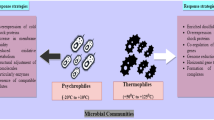Abstract
Over ten years, the individuals of an orthoclone of Notommata copeus gradually lost their sensitivity to photoperiod. This loss is transmissible but reversible in three generations. It is endogenous but not chromosomal. The hypothesis is forwarded that it is induced by external factors, and quite possibly crowding.
Similar content being viewed by others
References
Birky, C. W. 1964. Studies on the physiology and genetics of the rotifer Asplanchna. I. Methods and physiology. J. expl. Zool. 155: 273–288.
Birky, C. W. & Gilbert, J. J. 1972. Vitamin E as an extrinsic and intrinsic signal controlling development in the rotifer Asplanchna: uptake, transmission and localization of [3H]α-tocopherol. J. Embryol. expl. Morphol. 27: 103–120.
Clément, P. & Pourriot, R. 1973. Mise en évidence d'un effet de masse et d'un effet de groupe dans l'apparition de phases de reproduction sexuée chez Notommata copeus (Rotifère). C.r. Acad. Sci. sér. D, 277, 22: 2533–2536.
Clément, P. & Pourriot, R. 1975. Influence du groupement et de la densité de population sur le cycle de reproduction de Notommata copeus Ehr. (Rotifère). I Mise en évidence et essai d'interprétation. Arch. Zool. expl. gén. 116: 375–421.
Clément, P. & Pourriot, R. 1979. Influence de l'âge des grandparents sur l'apparition des mâles chez le Rotifère Notommata copeus Ehr. Int. J. Invert. Reprod. 1: 89–98.
Clément, P., Rougier, C. & Pourriot, R. 1976. Les facteurs exogènes et endogènes qui contrôlent l'apparition des mâles chez les Rotifères. Bull. Soc. Zool. Fr. 101, Suppl. 4: 86–95.
King, C. E. 1969. Experimental studies of ageing in Rotifers. Expl. Geront. 4: 63–79.
Lansing, A. I. 1947. A transmissible, cumulative and reversible factor in aging. J. Geront. 2: 228–239.
Pourriot, R. 1963, Influence du rythme nycthéméral sur le cycle sexuel de quelques Rotifères. C.r. Acad. Sci. Paris, sér. D, 256: 5216–5219.
Rougier, C. & Pourriot, R. 1977. Aging and control of reproduction in Brachionus calyciflorus (Pallas) (Rotifere). Expl. Geront. 12: 137–151.
Ruttner-Kolisko, A. 1969. Kreuzungsexperimente zwischen Brachionus urceolaris und B. quadridentatus, ein Beitrag zur Fortpflanzungsbiologie der heterogonen Rotatoria. Arch. Hydrobiol. 65: 397–412.
Author information
Authors and Affiliations
Rights and permissions
About this article
Cite this article
Clément, P., Pourriot, R. About a transmissible influence through several generations in a clone of the rotifer notommata copeus EHR. Hydrobiologia 73, 27–31 (1980). https://doi.org/10.1007/BF00019418
Issue Date:
DOI: https://doi.org/10.1007/BF00019418




